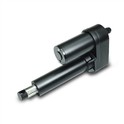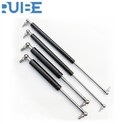As a supplier of gas springs for furniture, I've witnessed firsthand how various environmental factors can impact the performance and longevity of these essential components. One such factor that often goes unnoticed but can have a significant influence is humidity. In this blog post, I'll delve into the effects of humidity on gas springs for furniture and why it's crucial to consider this when selecting and using these products.
Understanding Gas Springs for Furniture
Before we explore the impact of humidity, let's briefly understand what gas springs are and their role in furniture. Gas springs are mechanical devices that use compressed gas to provide controlled motion and support. In the furniture industry, they are commonly used in applications such as Kitchen Cabinet Gas Spring, Gas Spring for Tool Box, and Murphy Bed Gas Spring. They offer smooth opening and closing actions, enhance user experience, and improve the functionality of furniture.
How Humidity Affects Gas Springs
Humidity refers to the amount of water vapor present in the air. High humidity levels can create a moist environment that poses several challenges to gas springs. Here are some of the ways humidity can impact gas springs for furniture:
Corrosion
One of the most significant effects of high humidity on gas springs is corrosion. When gas springs are exposed to a humid environment, the moisture in the air can react with the metal components of the gas spring, leading to rust and corrosion. Corrosion weakens the structural integrity of the gas spring, reducing its strength and durability. Over time, this can cause the gas spring to fail prematurely, resulting in issues such as sagging doors or drawers that won't stay open.


Seal Degradation
Gas springs rely on seals to maintain the pressure of the compressed gas inside. High humidity can cause these seals to degrade over time. The moisture can penetrate the seals, causing them to swell, crack, or lose their elasticity. As a result, the gas spring may start to leak gas, leading to a loss of pressure and a decrease in performance. This can make the furniture difficult to open or close, and in some cases, the gas spring may stop working altogether.
Lubrication Breakdown
Lubrication is essential for the smooth operation of gas springs. It reduces friction between the moving parts of the gas spring, preventing wear and tear. However, high humidity can cause the lubricant to break down. The moisture in the air can mix with the lubricant, diluting it and reducing its effectiveness. This can lead to increased friction, which not only affects the performance of the gas spring but also accelerates the wear of the components.
Freezing in Cold Humid Conditions
In cold and humid environments, the moisture in the air can freeze inside the gas spring. This can cause the gas spring to become stiff and difficult to operate. In extreme cases, the frozen water can expand, causing damage to the gas spring's internal components.
Mitigating the Effects of Humidity
While high humidity can pose challenges to gas springs for furniture, there are several steps that can be taken to mitigate these effects:
Material Selection
Choosing the right materials for gas springs is crucial in humid environments. Stainless steel is a popular choice as it is highly resistant to corrosion. Additionally, gas springs with protective coatings can provide an extra layer of defense against moisture. Some manufacturers offer gas springs with special coatings that are designed to resist corrosion and prevent moisture from reaching the metal components.
Proper Installation
Proper installation of gas springs is essential to ensure their optimal performance. Gas springs should be installed in a dry environment, away from sources of moisture. It's also important to follow the manufacturer's installation instructions carefully to ensure that the gas springs are installed correctly and securely.
Regular Maintenance
Regular maintenance can help extend the lifespan of gas springs in humid environments. This includes inspecting the gas springs for signs of corrosion, seal degradation, or lubrication breakdown. If any issues are detected, they should be addressed promptly. Lubrication should be checked and replenished as needed to ensure smooth operation.
Environmental Control
Controlling the humidity levels in the environment where the furniture is located can also help protect the gas springs. Using dehumidifiers in areas with high humidity can reduce the moisture in the air, creating a more favorable environment for the gas springs. Additionally, keeping the furniture away from areas prone to moisture, such as near windows or in basements, can help prevent exposure to high humidity.
Conclusion
Humidity can have a significant influence on gas springs for furniture. Corrosion, seal degradation, lubrication breakdown, and freezing are some of the challenges that high humidity can pose. However, by selecting the right materials, ensuring proper installation, conducting regular maintenance, and controlling the environment, these effects can be mitigated.
As a supplier of gas springs for furniture, I understand the importance of providing products that can withstand various environmental conditions. We offer a wide range of gas springs that are designed to perform well in humid environments. Our gas springs are made from high-quality materials and are engineered to provide reliable and long-lasting performance.
If you're in the market for gas springs for your furniture, whether it's for kitchen cabinets, tool boxes, or Murphy beds, I encourage you to contact us to discuss your specific requirements. We're here to help you find the right gas springs for your application and ensure that they perform optimally in your environment.
References
- ASM Handbook, Volume 13A: Corrosion: Fundamentals, Testing, and Protection. ASM International.
- Machinery's Handbook, 31st Edition. Industrial Press Inc.
- Manufacturer's guidelines for gas spring installation and maintenance.






